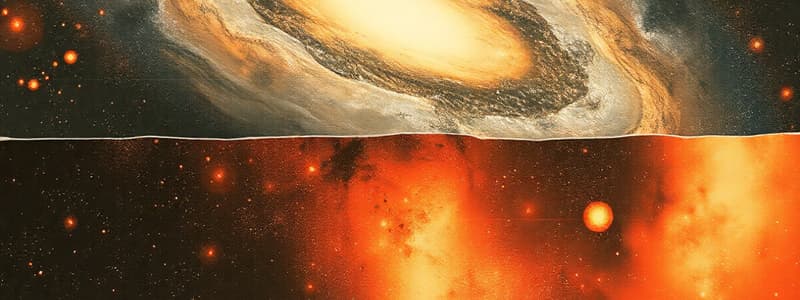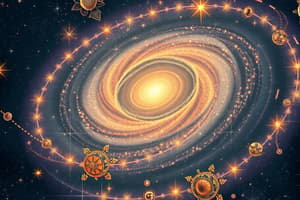Podcast
Questions and Answers
What is an astronomical unit (AU)?
What is an astronomical unit (AU)?
- The distance light travels in one year
- The average distance from Earth to the Sun (correct)
- The average distance from Earth to another galaxy
- The mass of a star compared to the Sun
The Big Bang Theory suggests that the universe has always existed in its current form.
The Big Bang Theory suggests that the universe has always existed in its current form.
False (B)
What evidence supports the Big Bang Theory?
What evidence supports the Big Bang Theory?
Red shift and Cosmic Microwave Background Radiation (CMB)
The closest star system, _____, is approximately 4.3 light years away from Earth.
The closest star system, _____, is approximately 4.3 light years away from Earth.
Match the following types of galaxies with their characteristics:
Match the following types of galaxies with their characteristics:
What does red shift indicate about distant galaxies?
What does red shift indicate about distant galaxies?
A galaxy's mass has no impact on its fate.
A galaxy's mass has no impact on its fate.
What is the current observation regarding the expansion of the universe?
What is the current observation regarding the expansion of the universe?
Which planet is known for having the largest volcano in the solar system?
Which planet is known for having the largest volcano in the solar system?
Gas giants are primarily made of rocky materials.
Gas giants are primarily made of rocky materials.
What is the main difference between a neutron star and a black hole?
What is the main difference between a neutron star and a black hole?
The _______ is the center of our solar system.
The _______ is the center of our solar system.
Match the celestial objects with their descriptions:
Match the celestial objects with their descriptions:
What effect does the Moon have on Earth?
What effect does the Moon have on Earth?
The Solar Eclipse occurs when Earth blocks sunlight from reaching the Moon.
The Solar Eclipse occurs when Earth blocks sunlight from reaching the Moon.
What is the theoretical model where Earth is considered the center of the universe?
What is the theoretical model where Earth is considered the center of the universe?
The largest planet in the solar system is _______.
The largest planet in the solar system is _______.
Which of the following planets is known for its retrograde rotation?
Which of the following planets is known for its retrograde rotation?
The supernova is the result of a star's explosion at the end of its life cycle.
The supernova is the result of a star's explosion at the end of its life cycle.
What astronomical phenomenon occurs when Earth blocks sunlight from reaching the Moon?
What astronomical phenomenon occurs when Earth blocks sunlight from reaching the Moon?
____ is an example of a black hole located at the center of the Milky Way.
____ is an example of a black hole located at the center of the Milky Way.
Match the planets with their classifications:
Match the planets with their classifications:
Flashcards
Astronomical Unit (AU)
Astronomical Unit (AU)
The average distance between the Earth and the Sun.
Light Year
Light Year
The distance light travels in one year.
Spiral Galaxy
Spiral Galaxy
A galaxy with a disk shape, stars forming in arms, and both young and old stars.
Red Shift
Red Shift
Signup and view all the flashcards
Big Bang Theory
Big Bang Theory
Signup and view all the flashcards
Hubble's Law
Hubble's Law
Signup and view all the flashcards
Dark Energy
Dark Energy
Signup and view all the flashcards
Star's Fate
Star's Fate
Signup and view all the flashcards
Low mass stars lifecycle
Low mass stars lifecycle
Signup and view all the flashcards
Medium mass stars lifecycle
Medium mass stars lifecycle
Signup and view all the flashcards
High mass stars lifecycle
High mass stars lifecycle
Signup and view all the flashcards
Terrestrial planets
Terrestrial planets
Signup and view all the flashcards
Gas giants
Gas giants
Signup and view all the flashcards
Geocentric theory
Geocentric theory
Signup and view all the flashcards
Heliocentric theory
Heliocentric theory
Signup and view all the flashcards
Supernova
Supernova
Signup and view all the flashcards
Nebula
Nebula
Signup and view all the flashcards
Constellation
Constellation
Signup and view all the flashcards
Asteroid Belt
Asteroid Belt
Signup and view all the flashcards
Solar Flare
Solar Flare
Signup and view all the flashcards
Solar Prominence
Solar Prominence
Signup and view all the flashcards
Rotation
Rotation
Signup and view all the flashcards
Study Notes
Astronomy Study Notes
- Astronomy: The scientific study of the universe, celestial objects (stars, planets, comets, galaxies), and phenomena beyond Earth's atmosphere. It helps understand the universe's origin, structure, future, and Earth's place within it.
Units of Measurement
- Astronomical Unit (AU): The average distance from Earth to the Sun.
- Light Year: The distance light travels in a year.
Galaxy Types
- Spiral Galaxies: Disk-shaped, with stars forming in arms; contain both young and old stars.
- Elliptical Galaxies: Round or oval-shaped; no ongoing star formation, mostly old stars; most common type.
- Irregular Galaxies: No defined shape; often formed from collisions; active star formation.
Redshift and the Expanding Universe
- Redshift: Light from distant galaxies shifts towards red wavelengths, indicating they are moving away; evidence for an expanding universe. Discovered by Edwin Hubble.
- Big Bang Theory: The prevailing theory that the universe began 13.7 billion years ago from an extremely dense, hot point that rapidly expanded. Supported by redshift and Cosmic Microwave Background Radiation (CMB). The Big Bang created the first light elements: hydrogen, helium, and lithium. This happened in the initial minutes after the intense expansion.
- Hubble's Law: The speed at which a galaxy moves away is proportional to its distance from us; the farther a galaxy, the faster it's receding. Supports the expanding universe concept.
- Balloon Model of Expansion: Space expands like the surface of an inflating balloon. Galaxies are like dots on the balloon's surface, moving apart as the balloon expands.
- Dark Energy: The mysterious force causing the accelerating expansion of the universe.
Star Life Cycles and Fate
- Star's Fate: A star's mass determines if it becomes a white dwarf, neutron star, or black hole.
- Low Mass Star: Main sequence → Red dwarf → White dwarf (e.g., Proxima Centauri)
- Medium Mass Star: Main sequence → Red giant → Planetary nebula → White dwarf (e.g., Sun)
- High Mass Star: Main sequence → Supergiant → Supernova → Neutron star or black hole (e.g., Betelgeuse)
Components of Our Solar System
-
Sun: The central star of our solar system.
-
Terrestrial Planets: Small, rocky planets close to the Sun: Mercury, Venus, Earth, Mars
-
Gas Giants: Large, gaseous planets far from the Sun: Jupiter, Saturn, Uranus, Neptune.
-
Terrestrial Planets Characteristics
- Mercury: Closest to the Sun; extremely hot during the day, freezing at night; no atmosphere, no moon.
- Venus: Similar size to Earth but thick toxic clouds; hottest planet due to the greenhouse effect; extremely slow and retrograde rotation.
- Earth: Unique planet for supporting life; liquid water surface; one moon; atmosphere protects from radiation and traps heat.
- Mars: Known as the red planet; iron-rich soil; largest volcano in our solar system; thin atmosphere; very cold.
-
Gas Giants Characteristics
- Jupiter: Largest planet; Great Red Spot (giant storm); numerous moons, including Titan; thick atmosphere.
- Uranus: Rotates on its side; pale blue due to methane; very cold; faint rings; 27 known moons.
- Neptune: Farthest from the Sun; deep blue; strongest winds in the solar system; faint rings; 14 moons, including Triton, that orbits backwards.
-
Asteroid Belt: Between Mars and Jupiter.
-
Comets: Icy bodies with glowing tails when near the Sun.
-
Moon: Earth's natural satellite.
Effects of the Sun and Moon
- Sun: Provides light, heat, and energy; causes seasons.
- Moon: Creates tides and stabilizes Earth's tilt.
- Eclipses: Solar eclipse (Moon blocks the Sun); Lunar eclipse (Earth blocks sunlight from the Moon).
Historical Models of the Universe
- Geocentric Theory: Earth is the center of the universe (e.g., Ptolemy). Replaced with the heliocentric theory (Sun-centered), credited to Copernicus and Galileo.
- Heliocentric Theory: The Sun is at the centre of the Universe.
Benefits and Costs of Space Research
- Benefits: Technological advancements (GPS, satellites, medical imaging); knowledge about the universe; economic growth.
- Costs and Hazards: High expense; radiation exposure; microgravity effects; accidents.
Additional Astronomical Concepts (Definitions/Examples)
- Supernova: Massive star explosion, e.g., Supernova SN 1987A
- Nebula: Cloud of gas and dust where stars form, e.g., Orion Nebula
- Constellation: Pattern of stars in the sky, e.g., Orion
- Star Cluster: Group of physically close, together-formed stars, e.g., Pleiades
- Neutron Star: Dense remnant of a massive star, e.g., Crab Pulsar
- Black Hole: Region with immense gravity, nothing escapes, e.g., Sagittarius A* (Milky Way's center)
- Solar Flares: Explosive energy bursts from the Sun, e.g., a 2017 flare.
- Solar Prominences: Large gas loops from the Sun's surface, e.g., a 2011 prominence.
- Sunspots: Cooler, darker regions on the Sun, by magnetic activity.
- Terrestrial Planets: Rocky, close-to-Sun planets, e.g., Earth & Mars
- Gas Giants: Large gaseous planets far from the Sun, e.g., Jupiter & Saturn
- Comet: Icy body with a glowing tail, e.g., Halley's Comet
- Asteroid: Small rocky object, e.g., Ceres (largest asteroid)
- Meteor: Streak of light from a meteoroid entering Earth's atmosphere
- Meteoroid: Small rock or particle in space (pre-atmosphere entry)
- Meteorite: Meteoroid surviving atmospheric entry and landing on Earth, e.g., Hoba meteorite
- Rotation: A planet's spin on its axis.
- Revolution: A planet's orbit around the Sun.
- Solar Eclipse: Moon blocks the Sun's light.
- Lunar Eclipse: Earth blocks the Sun's light from the Moon.
- Solstice: Longest/shortest days of the year.
- Equinox: Day and night are equal.
- Refracting Telescope: Uses lenses.
- Reflecting Telescope: Uses mirrors.
Studying That Suits You
Use AI to generate personalized quizzes and flashcards to suit your learning preferences.




